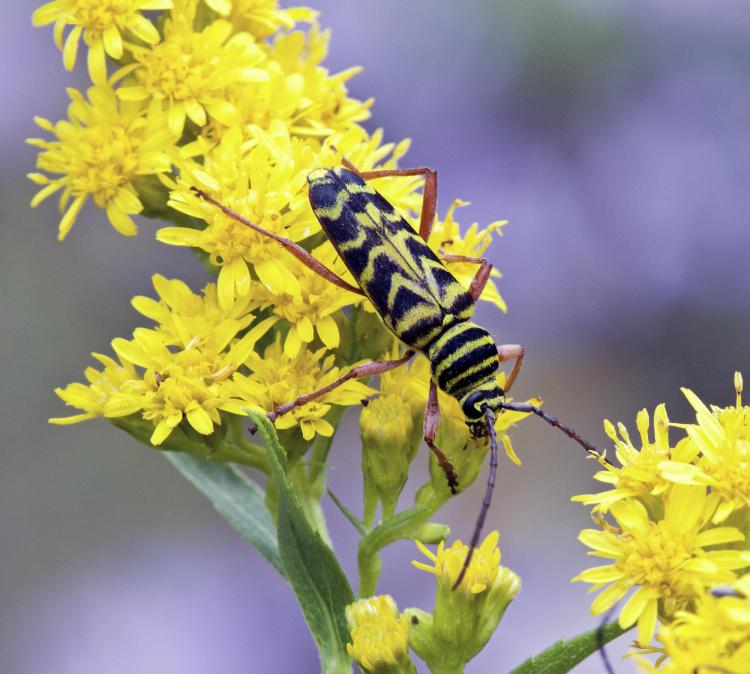Bright beetle gains protection through similarity to wasps
A defenseless insect can gain protection from predators if it evolves to resemble a well-defended species. This evolved similarity is called mimicry, and most familiar are examples of edible butterflies that mimic butterflies defended by chemical defenses.
But an animal need not have chemical defenses to serve as a model in mimicry — as long as an animal is adequately defended, resemblance to that species can benefit a mimic. Some of my favorite models for mimicry are bees and wasps.
Locust borers are large and slow longhorn beetles that consume primarily the pollen of goldenrods. Click on this link or on photo for larger image. Photo by Jeff Mitton.
The value of being mistaken for a bee or wasp is that most predators have learned to leave them alone. Unlike the familiar honey bee, which dies after stinging, solitary bees and wasps can sting multiple times. I remember, when I was more naïve, mowing a lawn dressed only in sneakers and shorts.
My mower blew grass fragments into a wasp nest and before I could react, a wasp emerged and made one quick pass at me, stinging me seven times on the ankle, leg, abdomen, chest and neck. That was more than 50 years ago, but the lesson is still vivid in my mind.
Locust borers are long-horned beetles that lay eggs in crevices or wounds of black locust trees. When the eggs hatch, the larvae burrow to the heartwood, but then emerge in mid to late summer as large black beetles with numerous bright yellow stripes. The stripes are aposematic or warning coloration, but the warning is a ruse, for they are mimics of wasps but have no defenses of their own.
In late summer, locust borers, Megacyllene robiniae, appear on goldenrods to feast on their abundant pollen. But they are not alone, for several wasps, including Polistes dominula and P. fuscatus, are eating pollen at the same time on the same plants. Fast, stinging wasps are generally to be avoided, both by humans and predators of insects. As the predators avoid wasps, they inadvertently avoid locust borers, which are large, slow, harmless and edible.
Locust borers, bee flies and clearwing moths have no defenses at all, but mimicry allows them to fly beneath the radar of predators."
We are accustomed to think of mimicry as evolution of similar shape and colors, but cases of symmetry may also include similar behaviors, such as the hovering and buzzing of bee flies. But locust borers have also evolved a similar fragrance.
The alarm pheromone of wasps, which calls other wasps to the aid of a threatened individual, includes specific chemical compounds called spiroacetals. But if you pick up an adult locust borer and shake it in your cupped hands, it emits an unpleasant odor that includes the very same spiroacetals as used by sympatric wasps. So when a wasp or locust borer is threatened, it emits the same chemical.
Thus, the mimicry of locust borers for wasps includes both colors and chemical alarm signals, and this specific case of mimicry is made even more effective by the intermixing of borers and wasps on goldenrod.
Bees and wasps are the models for many mimics, and I enjoy several other mimics that I have found locally. Bee flies are fuzzy and they buzz like bees and hover at flowers like bees, but they are parasitic flies that drink nectar as adults and lay their eggs on caterpillars of any butterfly or moth. Clearwing moths fly during the day, and unlike most moths, they have few or no scales on the wings, so their wings resemble those of bees or wasps. Depending on which species of moth it is, they mimic either bumble bees or wasps. The mimics of bumble bees are large and furry, and they even buzz as they move among flowers. The mimics of wasps have long, narrow wings and their bodies are black with bands of yellow.
Locust borers, bee flies and clearwing moths have no defenses at all, but mimicry allows them to fly beneath the radar of predators.


